Ford Country Squire
| Ford Country Squire | |
|---|---|
 1982 Ford LTD Country Squire | |
| Overview | |
| Manufacturer | Ford |
| Also called | Ford LTD Country Squire |
| Model years | 1950–1991 |
| Body and chassis | |
| Class | Full-size station wagon |
| Body style |
2-door station wagon 4-door station wagon |
| Related | |
| Chronology | |
| Predecessor | 1948 Ford station wagon |
The Ford Country Squire (later the Ford LTD Country Squire) is a product range of station wagons that was assembled by Ford Motor Company from the 1950 to 1991 model years. Marketed as the premium station wagon of the Ford division, the Country Squire was distinguished by its woodgrain body trim. As of the 2019 model year, the 41-year production run of the Country Squire is the third-longest of a Ford car nameplate in North America, surpassed only by the Ford Thunderbird (46 years) and Ford Mustang (55 years, currently in production).
As part of the full-size Ford model range, the Ford Country Squire was sold across seven generations, becoming the station wagon counterpart of several model lines. From 1950 to 1954, the Country Squire was based upon the Ford Custom Deluxe (and the Ford Crestline that replaced it). In 1955, Ford shifted station wagons into a stand-alone model range, with the Country Squire sharing its trim with the Ford Fairlane (and the later Ford Galaxie). In 1969, Ford consolidated sedans and station wagons into a single model range, with the Country Squire becoming a station wagon version of the Ford LTD. As the model line was renamed the Ford LTD Crown Victoria in 1983, the Country Squire remained part of the full-size range through its 1991 discontinuation.
From 1961 to 1991, the Mercury Colony Park was marketed as the Mercury counterpart of the Country Squire, sharing nearly all exterior bodywork and trim. Prior to 1979, the Colony Park was the sole full-size Mercury to share a wheelbase with Ford vehicles.
For the 1992 model year, the Ford Crown Victoria was introduced only as a four-door sedan, leaving the Country Squire with no direct replacement through its 2011 discontinuation. As of the 2019 model year, Ford does not sell a sedan-based station wagon in North America.
Woodgrain trim
Although all Ford Country Squires feature wood-grain body trim, only the first-generation 1950-1951 versions are true "Woodies". To reduce the production cost of station wagons, for 1952, Ford replaced wooden body construction with an all-steel body. Subsequently, exterior body trim consisted of simulated woodgrain (with varying degrees of coverage on the body). The genuine wood body panels were manufactured at the Ford Iron Mountain Plant in the Michigan Upper Peninsula from lumber owned by Ford Motor Company.
During the 1960s, 1970s and early 1980s, other variations of the Squire name would be used on other Ford wood-grained station wagons, including the Falcon, Fairlane, Torino, Pinto, Gran Torino, LTD II, Fairmont, Escort, and mid-size LTD (the last to use the Squire name).
First generation (1950–1951)
| First generation | |
|---|---|
 1950 Ford Country Squire | |
| Overview | |
| Production | 1950–1951 |
| Body and chassis | |
| Body style | 2-door station wagon |
| Platform | 1949 Ford |
| Related | Ford Custom Deluxe |
| Powertrain | |
| Engine | |
| Dimensions | |
| Wheelbase | 114 in (2,896 mm) |
The 1950 Ford model range included a station wagon which, at the time of its introduction, was marketed as part of the top-line Custom Deluxe trim.[1] In the following spring, Ford began promoting the wagon as the Country Squire, although that name did not appear anywhere on the car. Along with the name change came the addition of a fold-down middle-row seat.[1] Following the rest of the Ford lineup, the Country Squire was available with a standard 226 cid inline six-cylinder engine as or an optional V-8.[1]
The first generation Country Squire was the beginning of the end of the full "woodie". The whole body was made of steel, unlike the Ford wagons up to 1948 that were all wood from the cowl back except for the rear fenders. Real wood attached to the steel body on the doors, sides and tailgate of the 1949 thru 1951 models, and Ford did not offer a woodless version. The interiors were all paneled in wood also. GM would later introduce a two-door station wagon in 1955 called the Chevrolet Nomad and Pontiac Safari.
Second generation (1952–1954)
| Second generation | |
|---|---|
|
1954 Ford Country Squire | |
| Overview | |
| Also called | Ford Country Sedan |
| Production | 1952–1954 |
| Body and chassis | |
| Body style | 4-door station wagon |
| Platform | 1952 Ford |
| Related |
Ford Crestline Mercury Eight wagon |
| Powertrain | |
| Engine | |
| Dimensions | |
| Wheelbase | 115 in (2,921 mm) |
In 1952, Ford expanded station wagons into a lineup separate from its newly redesigned sedans. The Country Squire was the top model, now available solely in a four-door configuration; it was the wagon counterpart of the Crestline series. Joining the Squire were the four-door Country Sedan (Customline) and the two-door Ranch Wagon (Mainline). The 239 Strato-Star V-8 was the only engine offered in the 1952 Country Squire.[2]
Unlike its predecessor, the 1952 Country Squire no longer was a true woodie; like the Country Sedan, it wore a full steel body. The woodgrain finish was now constructed by woodgrain transfers edged in real wood trim on the sides and tailgate.The real wood trim was discontinued halfway thru the 1953 model run and replaced with fiberglass trim with a woodgrain finish.[2]
Third generation (1955–1959)
| Third generation | |
|---|---|
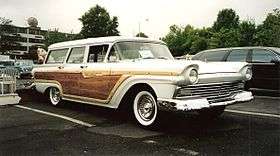 1957 Ford Country Squire | |
| Overview | |
| Production | 1955–1959 |
| Body and chassis | |
| Body style | 4-door station wagon |
| Related |
Ford Fairlane Edsel Bermuda Edsel Villager |
| Dimensions | |
| Wheelbase |
1955-1956: 115.5 inches 1957-1958: 116 inches 1959: 118 inches |

For the 1955 model year, Ford station wagons became a separate model range from the sedans, coupes, and convertibles. The woodgrained Country Squire was the top-of-the-line model, trimmed similar to the Fairlane. For the first time, all wood trim was simulated with vinyl decals.
Sharing a common wheelbase with the rest of the Ford model line, the Country Squire saw little visible change from 1955 to 1956. For 1956, a 12-volt electrical system became standard equipment. The Lifeguard package became a new option for 1956, with few takers.
For 1957, the Ford model line grew longer and lower as part of a major redesign; a major factor of the new chassis was the upcoming introduction of the Edsel line for 1958. The Country Squire body and interior would be used for the production of the non-woodgrain Edsel Villager and the top-trim Edsel Bermuda (distinguished by its combination of woodgrain sides and two-tone paint).
For 1959, after only 2,235 were produced, the Edsel Bermuda was dropped, trimming the division's range solely to the Villager. However, in a movement to stay competitive with other manufacturers, all 1959 Fords were lengthened; the wheelbase was increased from 116 to 118 inches. Following the change in the sedan line, the Country Squire was trimmed similar to the newly introduced Galaxie.
In Australia, where the Ford model lineup began local production in 1959, the 1959 body style used for only one year in the US and Canada, the Country Sedan was sold until 1962. The Country Squire was never sold in Australia. This generation is referred to locally as "Tank Fords" because of their size (in comparison to the Ford Cortina sold at the same time).
Fourth generation (1960–1964)
| Fourth generation | |
|---|---|
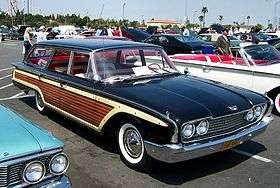 1960 Ford Country Squire | |
| Overview | |
| Model years | 1960–1964 |
| Body and chassis | |
| Body style | 4-door station wagon |
| Related |
Ford Galaxie Ford Country Sedan Mercury Commuter Mercury Colony Park Mercury Meteor Mercury Monterey Lincoln Continental |
While again remaining a separate line for 1960, the Country Squire became the companion model to the newly introduced Galaxie. With the discontinuation of Edsel and the impending downsizing of the Lincoln line, all full-sized Mercurys adopted Ford bodies by 1961, the counterpart of the Country Squire was the Colony Park.
Prior to 1961, all Ford wagons used a two-piece tailgate assembly that required the operator to lift the rear window up and locking it into place via a mechanical support, and then drop the tail gate down to fully access the rear compartment. For 1961, Ford introduced a redesigned tailgate assembly using a self-storing window feature which could either be rolled down into the gate via crank on the outside of the gate, or by an electrical motor actuated by the key or an interior switch. A safety lockout measure required that the rear window had to be fully retracted into the tailgate before the tailgate could be lowered.
.jpg)
Fifth generation (1965–1968)
| Fifth generation | |
|---|---|
 1967 Ford Country Squire | |
| Overview | |
| Also called | Ford Country Sedan |
| Production | 1965–1968 |
| Body and chassis | |
| Body style | 4-door station wagon |
| Related |
Ford Galaxie Mercury Colony Park |
| Powertrain | |
| Transmission |
3-speed Borg-Warner T150 manual 4-speed Borg-Warner T85 overdrive manual 3-speed Cruise-o-Matic (C4) automatic |
| Dimensions | |
| Wheelbase | 119.0 in (3,020 mm)[3] |
| Length | 210.0 in (5,330 mm)[3] |
| Width | 77.4 in (1,970 mm)[3] |
| Height | 56.7 in (1,440 mm)[3] |
| Curb weight | 4,277 lb (1,940 kg)[3] |
For the 1965 model year, the chassis of the full-size Ford line was completely redesigned. The leaf-spring rear suspension was replaced with a three-link coil-spring layout; in various forms, this design would remain in use in full-size rear-wheel drive Fords until the discontinuation of the Crown Victoria over 45 years later. In addition, the long-running "valet key" made its debut for 1965.
During this generation, a number of running changes were made to accommodate changing federal safety regulations. For 1966, seat belts became standard equipment for all seats (front and rear). For 1967, the changes were more extensive, as the Country Squire redesigned the steering wheel (with a large, padded hub in the center) fitted to an energy-absorbing steering column,[28] padded interior surfaces, recessed controls on the instrument panel, and front outboard shoulder belt anchors. To ensure that the 4300-lb Country Squire would not be the victim of brake failure, another mandate required the introduction of a dual-chamber master cylinder (on the Country Squire and all other 1968 vehicles).
This generation introduced covered headlights, which were deployed using a vacuum canister system that kept the doors down when a vacuum condition existed in the lines, provided by the engine when it was running. If a loss of vacuum occurred, the doors would retract up so that the headlights were visible if the system should fail.
In 1966, all Ford wagons introduced the Magic Doorgate, engineered by Donald N. Frey,[4] which allowed the tailgate to flip down like a traditional tailgate or to open to the side as a swinging door. The Magic Doorgate was made possible through use of a traditional stationary hinge on the right, and combination of hinges along the door's left side which carried the weight of the gate as it swung outward when used as a door. The rear window had to be retracted into the door before it would open to the side, or fold down.
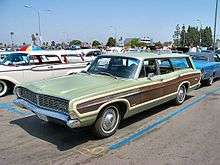
For 1968, the Country Squire wore “LTD” lettering above the grille but was still marketed as the “Ford Country Squire”.[5]
Sixth generation (1969–1978)
| Sixth generation | |
|---|---|
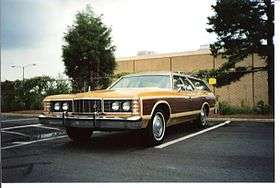 1973 Ford LTD Country Squire | |
| Overview | |
| Model years | 1969–1978 |
| Assembly |
Hazelwood, Missouri (St. Louis Assembly Plant) Pico Rivera, California (Los Angeles Assembly) Hapeville, Georgia (Atlanta Assembly) |
| Body and chassis | |
| Body style | 4-door station wagon |
| Related |
Mercury Colony Park Ford LTD Ford Galaxie Ford Custom |
| Powertrain | |
| Engine |
302 cu in (4.9 L) Windsor V8 351 cu in (5.8 L) Windsor V8 390 cu in (6.4 L) FE V8 429 cu in (7.0 L) 385 V8 400 cu in (6.6 L) Cleveland V8 460 cu in (7.5 L) 385 V8 351 cu in (5.8 L) 351M/351 Cleveland V8 |
| Transmission |
3-speed manual 3-speed FMX automatic 3-speed Ford C6 automatic |
| Dimensions | |
| Wheelbase | 121.0 in (3,073 mm) |
| Length | 225.7 in (5,733 mm) (1973-1978) |
For the 1969 model year, Ford ended its practice of distinct model lines for station wagons and sedans.[6] Alongside the Ranch Wagon and Country Sedan, the Country Squire were integrated into the three-model full-size Ford car lineup. Remaining at the top of the range, the Country Squire became part of the LTD lineup, gaining the prefix of that model.[7]
Approximately 7,850,000 full-size Fords and Mercurys were sold over 1969-78.[8][9] This makes it the second best selling Ford automobile platform after the Ford Model T.[6]
1969–1972

For the 1969 model year, a new generation of Ford and Mercury cars made their debut; station wagons for both divisions rode on a 121-inch wheelbase shared with the Ford sedan line, a gain of two inches. The "Magic Doorgate" tailgate was updated to a 3-way design: it could now swing down as a tailgate or swing out with the window down or up (the latter was previously not possible).[6]
As part of the LTD line, the Country Squire wore similar interior trim; with the obvious exception of its simulated woodgrain paneling, Country Squires wore the same bodywork from the windshield forward as their LTD sedan counterparts. For the 1970 model year, visible changes were limited to detail changes in bumper and grille trim. In 1971, the Country Squire would be given an extensive facelift (with only the roof and tailgate carried over from the 1970 model); as with the LTD, it would lose its hidden headlamps in the grille.
Initially, the standard engine was a 302 cubic-inch V8, replaced by a 351 cubic-inch V8 midway through the 1969 model year. As with its LTD counterpart, the 390 and 429 V8 engines were options. In 1971, the 390 V8 was replaced by a 402 cubic-inch V8 (though sold as a 400). For a variety of reasons, 1972 saw a major decrease in powertrain output. That year, gross horsepower was replaced by SAE net horsepower. The addition of emissions controls and adoption of unleaded fuel required lowered compression ratios and retarded ignition timing. In one example, the range-topping 429 V8 would see its output drop from 365 hp to 212 hp from 1971 to 1972. In 1972, the 429 was joined by a 224-hp 460 cubic-inch V8 seen previously in the Lincoln lineup.[6]
Production figures:
- 1969: 129,235
- 1970: 108,914
- 1971: 130,644
- 1972: 121,419
1973–1978

For the 1973 model year, the Ford full-size car line was given a major update.[6] While still built on the same chassis and 121-inch wheelbase, the addition of 5 mph bumpers would add over six inches in length to the LTD Country Squire by the end of the 1974 model year. These would also be the longest and heaviest station wagons ever produced by Ford.
For 1974, 5-mph bumpers were added to the rear, a transistorized ignition system was introduced, as well as a new hood ornament. In addition, the 429 was dropped, largely replaced by the essentially identical 460 V8.[6]
For 1975, Ford began to pare down its wagon lineup as the Custom 500 Ranch Wagon was relegated exclusively to fleet sales and the Galaxie Country Sedan was discontinued, replaced by a non-woodgrain LTD wagon. To better distinguish the LTD Country Squire, Ford returned hidden headlamps to the model, a feature associated with top-line LTD Landau (and Mercury Marquis) models. In all models, catalytic converters were now standard equipment to comply with emissions regulations.
1975-1978 models were nearly identical except for small differences in trim and emblems from year to year. As a move to increase fuel economy, the 351 cubic-inch V8 was reintroduced for 1978.[6]
The standard engine on all other full-size Ford sedans and wagons was the 351 Windsor V8. The Country Squire however, came standard with the Cleveland 400M V8, while the 385-series 429 and 460 V8s were optional. With manual transmissions being dropped from the lineup, the C6 3-speed automatic transmission was now the only transmission option for full-size Fords. The 429 and 460 V8s were a common option due to the especially sluggish performance of the detuned 400 engine that was now struggling to drive the ever-increasing weight of a Country Squire.
Seventh generation (1979–1991)
| Seventh generation | |
|---|---|
 1988-1989 Ford LTD Crown Victoria Country Squire | |
 Cargo area with rear seats folded (1982 model shown; other models are similar) | |
| Overview | |
| Production |
1979–December 1990 217,152 produced |
| Assembly | St. Thomas, Ontario, Canada |
| Body and chassis | |
| Body style | 4-door station wagon |
| Platform | Ford Panther platform |
| Related |
Ford LTD Ford LTD Crown Victoria Lincoln Continental Lincoln Town Car Mercury Colony Park Mercury Grand Marquis Mercury Marquis |
| Powertrain | |
| Engine |
4.9 L (302 cu in) 5.0 Windsor V8 5.8 L (351 cu in) 351 Windsor V8 |
| Transmission | 4-speed AOD automatic (1980–1990) |
| Dimensions | |
| Wheelbase | 114.3 in (2,903 mm) |
| Length |
215.7 in (5,479 mm)
|
| Width | 79.3 in (2,014 mm) |
| Height | 56.5 in (1,435 mm) |
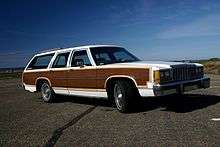
In 1979, Ford became the last American automaker to downsize its full-size car lines. Eleven inches shorter and nearly 1000 pounds lighter than its 1978 predecessor, the redesigned Country Squire retained its 8-passenger seating capability with only slightly reduced cargo capacity. The big-block 400 and 460 cubic-inch V8s were not included in the redesign, leaving the Country Squire with 302 cubic inch (4.9 liters, but marketed as 5.0) and 351 cubic inch (5.8 L) Windsor V8 engines.
The 1980s saw relatively few changes to the Country Squire. In 1983 the carbureted engine was replaced with throttle body fuel injection. For the 1986 model year, Ford went to sequential multi-port fuel injection which is identifiable by the large intake with the EFI 5.0 badge on top. In 1988, coinciding with the facelift of its LTD Crown Victoria counterpart, the Country Squire received a new front clip. Inside, new front seats with larger head restraints were added. For 1990 and 1991, the dashboard was updated (for the first time since 1979) with the addition of a driver's side airbag and the outboard rear seats received 3-point seatbelts.
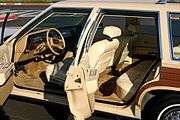

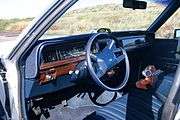


Discontinuation
During the mid-1980s, sales of full-size station wagons began to decline, following the introduction of the Chrysler minivans and the Ford Aerostar. By 1991, the Country Squire was the slowest-selling Ford vehicle in North America, with less than 4,000 produced.
For 1992, as Ford redesigned its Ford and Mercury full-size vehicles, the station wagon body style was not included in the redesign. General Motors redesigned its B-platform station wagons for 1991, which were poorly received in the marketplace.
At Ford, the role of the 8-passenger station wagon was passed onto the Ford Taurus/Mercury Sable; redesigned alongside the Crown Victoria for 1992, the Ford Taurus became the best-selling car in the United States. Functionally, the role of the family towing vehicle in the Ford product line was split between the Aerostar (and the larger Ford Club Wagon) as well as the then-new Ford Explorer (as buyers began to shift towards SUVs).
| Year | 1979 | 1980 | 1981 | 1982 | 1983 | 1984 | 1985 | 1986 | 1987 | 1988 | 1989 | 1990 | 1991 | Total |
|---|---|---|---|---|---|---|---|---|---|---|---|---|---|---|
| Units† | LTD Country Squire: 29,932 | LTD Country Squire: 9,868 7 | LTD Country Squire:9,443 | LTD Country Squire: 9,626 (9,294) | 20,343 | 30,803 | 30,825 | 20,164 | 17,562 | 14,940 | 13,362 | 6,419 | 3,865 | 221,017 |
| Non-woodgrain:37,955 | Non-woodgrain:11,718 |
|
Non-woodgrain: 9,294 |
†non-woodgrain LTD Crown Victoria and Country Squire wagons counted as one total starting in 1983
††286,673 units total, including non-woodgrain wagons produced 1979–1982
Unique options and features
With certain versions of the Country Squire one could install an AM/FM-Cassette stereo with a combined and fully integrated Citizens' Band (CB) two-way radio, and replacement dual-purpose automatic antenna (with only one visible difference; the aerial mast was a larger diameter, and black-band at approximately half-way up). The radio would then have the appearance of an original equipment, factory radio.
Options, included; opposing side-facing rear seats, which could be folded down to make a durable cargo surface. Available for use with the side-facing rear seats was a folding table with integrated magnetic checkers board. Magnets under the plastic checkers pieces would keep them from sliding on the board while the vehicle was in motion.
Behind a rear fender well was a hidden, lockable compartment, not visible when the rear seat back was in the upright position.
GM, Chrysler and AMC would adopt a similar configuration by the end of the 1960s. An advanced version of this was the 3-way tailgate which permitted opening the door sideways with the window up.
References
- 1 2 3 1950 Ford Country Squire, auto.howstuffworks.com Archived 2016-04-06 at the Wayback Machine. Retrieved on 4 December 2012
- 1 2 Auto editors of Consumers Guide (9 October 2007). "1952 Ford Country Squire". auto.howstuffworks. Retrieved 26 December 2015.
- 1 2 3 4 5 "1965 Ford Country Squire Station Wagon 390 Thunderbird Special V-8 overdrive (model since September 1964 for North America U.S.) specifications & performance data review". Retrieved 31 December 2015.
- ↑ "The Thinker (Detroit Style)". TIME. April 21, 1967. Retrieved 2007-07-27.
- ↑ Nineteen Sixty-Eight Ford sales brochure W363 (WO55 Revised) 12/67, page 21
- 1 2 3 4 5 6 7 Odin, L.C. A concise guide to the Ford and Mercury full-size automobile production 1969-1978. Belvedere Publishing, 2016. ASIN: B01HE91Y4K.
- ↑ Ford Wagons sales brochure 5029-8/68, page 12
- ↑ Kowalke, Ron (1997). Standard Catalog of American Cars 1946–1975. Krause publications. ISBN 0-87341-521-3.
- ↑ Flammang, James Standard Catalog of American Cars 1976–1999 3rd Edition (Iola, WI: Krause Publications, Inc 1999)
- ↑ "Box Panther Production Numbers". Retrieved 21 February 2014.
External links
| Wikimedia Commons has media related to Ford Country Squire. |
- Smithsonian Institution 1955 Ford Country Squire in the Smithsonian Automobile Collection
- LTDworld.com Website featuring a 1975 Ford LTD Country Squire
- Grandmarq.net Forum dedicated to the Ford, Lincoln, and Mercury Panther Chassis
- Ford Country Squire at the Internet Movie Cars Database
« previous — Ford car timeline, United States & Canada, 1980–present | ||||||||||||||||||||||||||||||||||||||||
|---|---|---|---|---|---|---|---|---|---|---|---|---|---|---|---|---|---|---|---|---|---|---|---|---|---|---|---|---|---|---|---|---|---|---|---|---|---|---|---|---|
| Type | 1980s | 1990s | 2000s | 2010s | ||||||||||||||||||||||||||||||||||||
| 0 | 1 | 2 | 3 | 4 | 5 | 6 | 7 | 8 | 9 | 0 | 1 | 2 | 3 | 4 | 5 | 6 | 7 | 8 | 9 | 0 | 1 | 2 | 3 | 4 | 5 | 6 | 7 | 8 | 9 | 0 | 1 | 2 | 3 | 4 | 5 | 6 | 7 | 8 | 9 | |
| Subcompact | Fiesta | Festiva | Aspire | Fiesta | ||||||||||||||||||||||||||||||||||||
| Compact | Pinto | Escort | Escort | Escort | ||||||||||||||||||||||||||||||||||||
| Focus | Focus | Focus | ||||||||||||||||||||||||||||||||||||||
| Fairmont | Tempo | Tempo | Contour | |||||||||||||||||||||||||||||||||||||
| Granada | ||||||||||||||||||||||||||||||||||||||||
| Mid-size | Granada | LTD | Fusion | Fusion | ||||||||||||||||||||||||||||||||||||
| Taurus | Taurus | Taurus | Taurus | |||||||||||||||||||||||||||||||||||||
| Full-size | LTD | LTD Crown Victoria | Crown Victoria | Crown Victoria | ||||||||||||||||||||||||||||||||||||
| Country Squire | Five Hundred / Taurus | Taurus | ||||||||||||||||||||||||||||||||||||||
| Personal luxury | Thunderbird | Thunderbird | Thunderbird | Thunderbird | ||||||||||||||||||||||||||||||||||||
| Sport compact | EXP | EXP | Probe | Probe | Escort ZX2 | ZX2 | Fiesta ST | |||||||||||||||||||||||||||||||||
| Focus ST | ||||||||||||||||||||||||||||||||||||||||
| Focus RS | ||||||||||||||||||||||||||||||||||||||||
| Sports car | Mustang | Mustang | Mustang | Mustang | ||||||||||||||||||||||||||||||||||||
| Supercar | GT | GT | ||||||||||||||||||||||||||||||||||||||